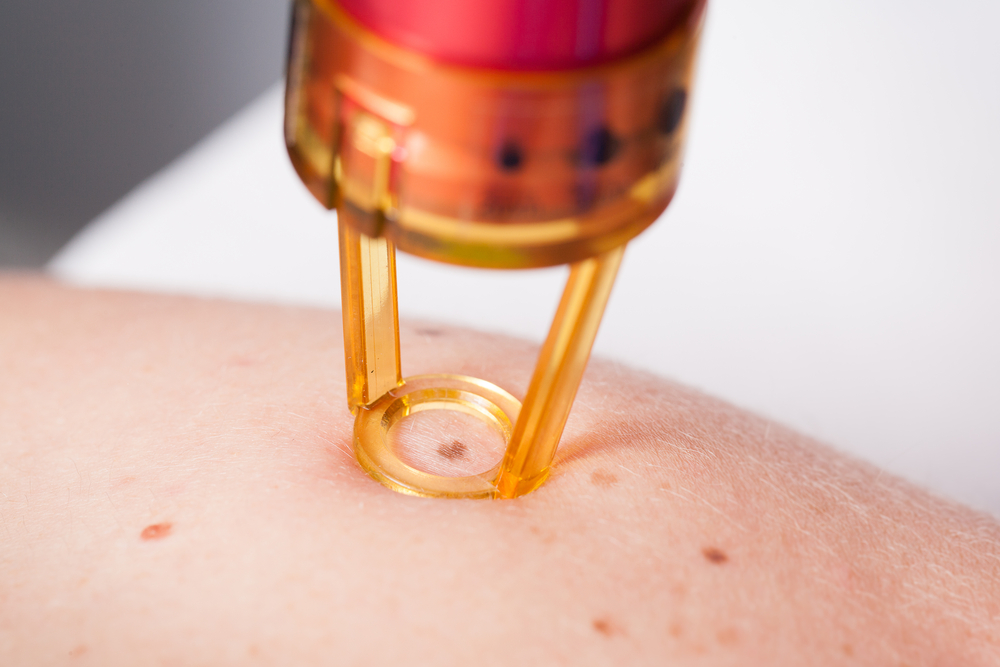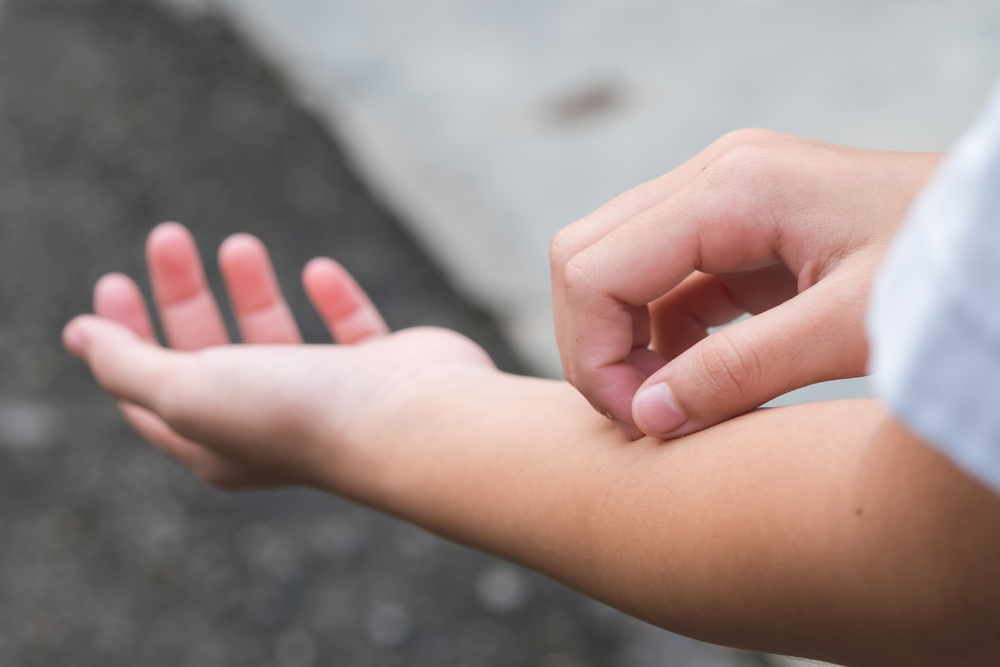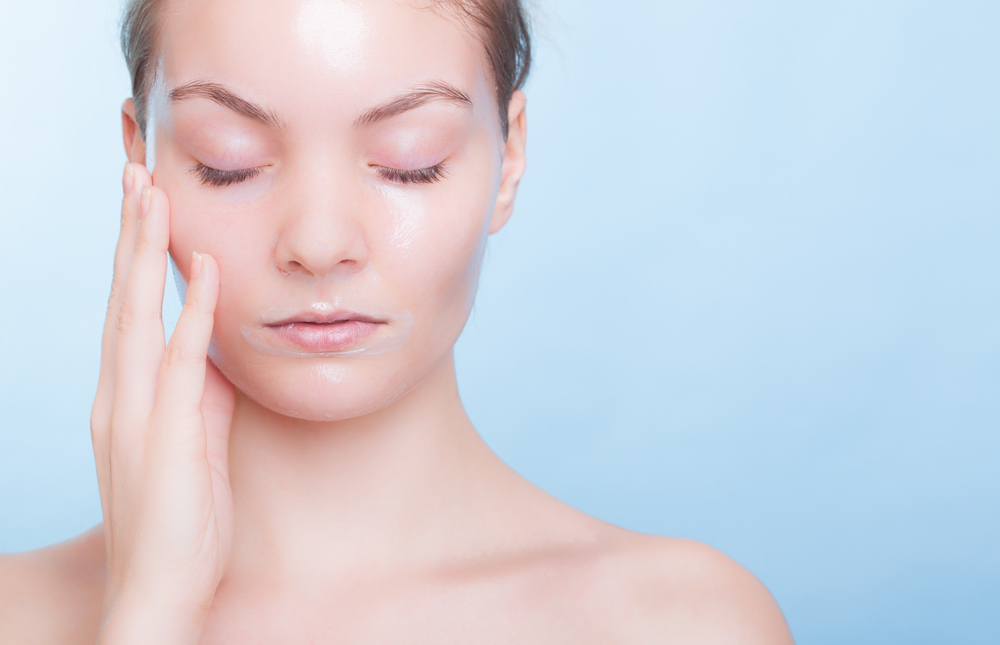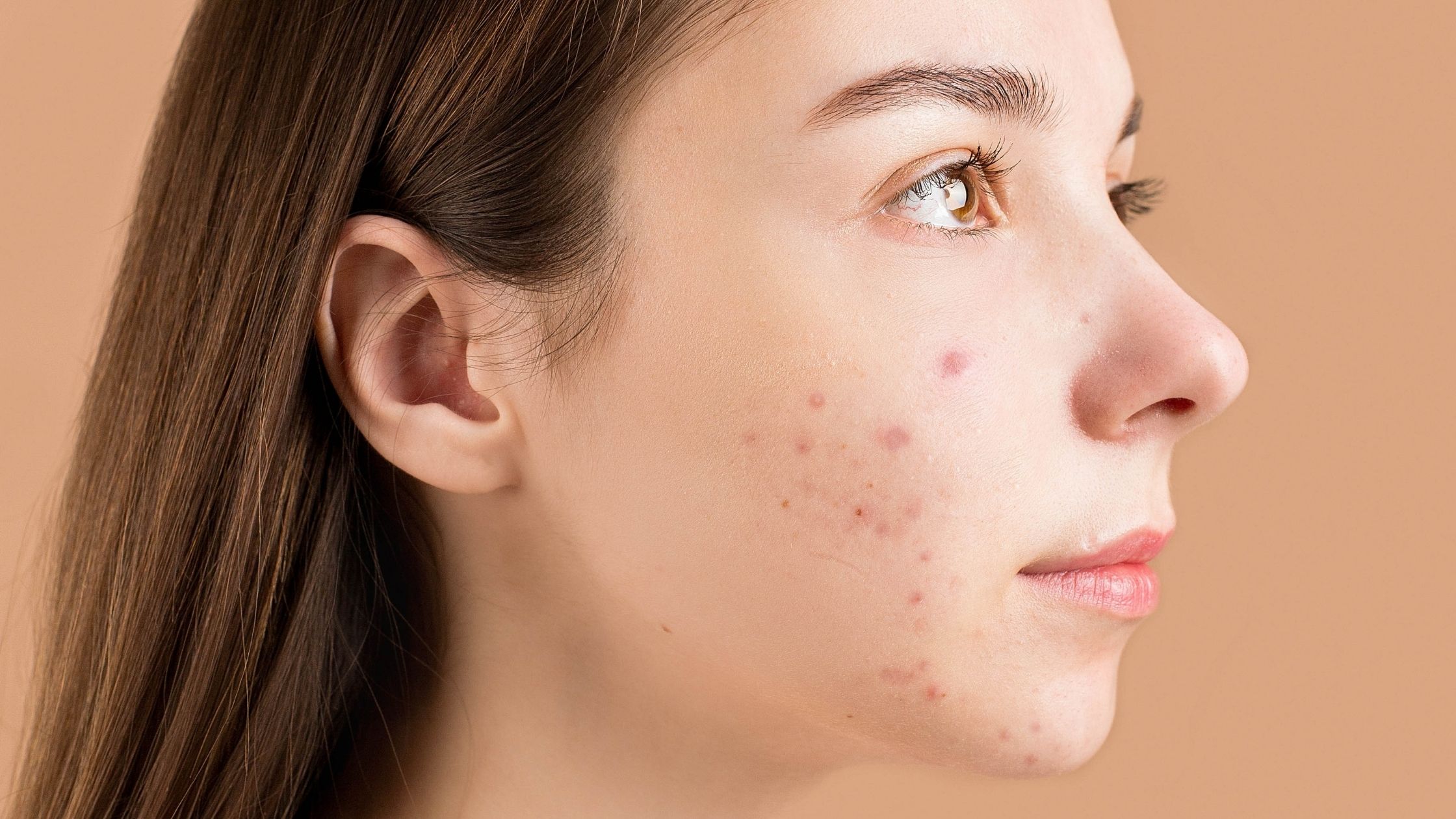- Some birthmarks can cover more than half of the face or body.
- Many birthmarks stem from a genetic mutation during fetal development.
- Many birthmarks disappear in early childhood.
- Some birthmarks can put you at a higher risk of cancer.
Birthmarks can be small mole-like spots hidden on the underside of your arm or large red patches covering a portion of your face. They can be so inconspicuous as to be easily ignored or they can be somewhat disfiguring. Many people don’t think twice about their birthmarks, but for some, they can take an emotional and physical toll.
Take Baby Ruby Ashby of Australia for example. She was born in 2015 with a rare birthmark called giant congenital melanocytic nevus. This large mole is accompanied by copious amounts of hair.
In Ruby’s case, the mole covered the upper right portion of her head and face, surrounding her eye down to the cheek bone. Concerned with her emotional and physical well-being, her parents started a GoFundMe account to help pay for the several surgeries it would take to rid her of the birthmark.
Before you scoff at the idea of paying to have the small port wine stain on your neck removed, it’s important to remember Baby Ruby and others like her. There are a wide
variety of birthmarks and, depending on the size, type, and location, many can be difficult to live with.
What causes birthmarks?
Birthmarks are defined as congenital skin irregularities, hence the name. However, birthmarks don’t have to be present immediately at birth. Some will show up within months of birth, as the immediate cause takes effect.
This immediate cause varies depending on the type of birthmark in question. The birthmark could be the result of a dilation of blood vessels, an overgrowth of skin pigment cells, or something else. What causes these conditions to occur is less certain.
In some cases, researchers can point to specific underlying causes. Some birthmarks, like the aforementioned congenital melanocytic nevus and port wine stain, are caused by mutations in a developing fetus. However, the deeper cause for many birthmarks is unknown.
Some researchers theorize that the development or migration of skin cells may be thrown off, possibly due to a portion of the placenta getting stuck inside an embryo during the early stages of development. Other researchers acknowledge a possible hereditary component for some birthmarks. However, most of them, including all vascular birthmarks, are not hereditary.
What are the different types of birthmarks?
The majority of birthmarks fall into one of two categories: pigmented or vascular. This depends on the immediate cause of the birthmark.
Pigmented Birthmarks
Pigmented birthmarks involve the clustering or overgrowth of pigment cells in certain areas of the body. As such, they tend to be different shades of brown or gray.
Mole
Also known as congenital melanocytic nevus, moles come in all shapes and sizes and can appear anywhere on the body. They tend to be very dark. In fact, the darker the skin tone of the affected individual, the darker the mole. It is important to note that not all moles are birthmarks. Some develop later in life for a variety of reasons.
Mongolian Spot
These grey spots, also called dermal melanocytosis, look almost like bruises. They tend to cluster on the lower back and buttocks of darker skinned people, particularly those of East Asian descent.
These birthmarks occur when melanocytes (cells contain melanin) fail to make it to the top layer of skin before a baby is born. They are relatively common and frequently disappear by the age of four or five.
Café au Lait
The name is French for “coffee with milk” and refers to the light tone of the birthmark, given these tan birthmarks look almost like coffee stains. Café au lait marks tend to be oval, but can sometimes be asymmetrical and highly irregular in shape. When this occurs, they are often referred to as “coast of Maine” spots.
These spots have a wide variety of direct causes, including several conditions that are associated with the marks. However, they generally result from an overproduction of melanin. They may fade with age but are unlikely to disappear entirely.
Vascular Birthmarks
Vascular birthmarks involve abnormalities in the blood vessels under certain patches of skin. These birthmarks are more red or purple in nature.
Port Wine Stain
Mikhail Gorbachev, former leader of the Soviet Union, is easily identified by the port wine stain on the top of his head. This irregularly shaped purple mark, also called a firemark, is caused by the abnormal development of blood vessels.
Blood vessels in a certain area of the body lack a sufficient supply of nerves, which causes them to widen (dilate). Blood collects in the area, leading to the deep shade of red. Port wine stains can grow and thicken over time, sometimes so much as to be disfiguring.
Hemangiomas
These red raised benign tumors come in two forms: strawberry and deep. The former are frequently referred to as strawberry marks for their pink coloring while the later tend to be more bruise-like in color and less noticeable in their early stages.
Hemangiomas result from an overgrowth of cells that line our blood vessels (epithelial cells). Typically, these marks begin small and flat but grow during infancy. They begin to shrink again after a child’s first birthday but can leave a permanent mark behind. While rare, these marks can grow in clusters.
Salmon Patches
These marks go by many names depending on where they are located. If found on the back of the neck, they are commonly called “stork bites.” If found on the face, particularly on or above the eyelids, they are called “angel kisses.”
Salmon patches are very common, occuring in nearly half of all infants. In most cases, the marks disappear within the first few years of life. But they sometimes persist into adulthood, especially those located on the back of the neck. As with port wine stains, salmon patches occur when blood vessels become dilated. However, while port wine stains result from a genetic mutation, the underlying cause for salmon patch vasodilation is unclear.
These are the most common types of birthmark. However, the American Academy of Dermatology recognizes certain rare congenital conditions as birthmarks, examples being aplasia cutis congenita, which involves the absence of skin on a portion of the scalp, and nevus sebaceous, which involves an overgrowth of skin and sebaceous glands on the scalp. Some people use “birthmark” as a blanket term to cover any marks presenting at birth regardless of the cause.
Should I have my birthmark removed?
People who seek birthmark removal typically do so for one of two reasons. They’re either concerned about their health or unhappy with their appearance.
Most birthmarks are harmless, but some may require medical intervention depending on the size, type, and location. For example, strawberry marks are generally not a concern. However, if they appear around or on the eye, they can interfere with eye development. They can also be cause for concern if found on the nose, mouth, or throat.
Moles are more concerning across the board. Large moles put individuals at a greater risk of developing cancer. Individuals should pay attention to the size, color, and shape of their moles. Moles that change color or become irregularly shaped may be malignant. It’s recommended that birthmarks be removed in these situations. Removal of moles in particular is extremely common, even before they become cancerous.
Sometimes otherwise harmless birthmarks are indicators for a more serious condition. Roughly 8-20% of people with port wine stains on their face also have neurological symptoms indicative of Sturge-Weber Syndrome. This condition develops from the same mutation that caused the birthmark and is said to cause seizures, eye problems, and learning disabilities.
Similarly, café au lait spots are sometimes associated with neurofibromatosis type 1, a genetic disorder that causes tumors, and McCune-Albright syndrome. Affected individuals should be checked out if he or she has more than six café au lait marks.
In cases where birthmarks are associated with other conditions, removing the birthmark is not of much help because it isn’t the birthmark causing the condition. Rather, the condition is causing the birthmark or they are both being caused by the same underlying factors.
Of course, there are those who simply dislike the look of their birthmark. Birthmarks range from barely noticeable, like a small café au lait in an out of the way area, to disfiguring, like a large mole in a visible location. Some of them become more noticeable with age, like port wine stains that tend to thicken and harden over time.
Having a birthmark removed for cosmetic reasons is perfectly valid. However, you first need to carefully consider the methods for removal and their associated side effects and weigh these factors against the emotional or psychological pain the birthmark causes you.
» If you’re considering birthmark removal, meet our Medical Review Team.
How can I get my birthmark removed?
There are a variety of methods for birthmark removal. Which method you use will depend on the type, size, and location of your birthmark.
Surgical Excision
This is the most direct form of birthmark removal. A surgeon will literally cut the birthmark out of your body. Surgical excision is most often done in the case of moles, especially large ones, to ensure complete removal. It’s also sometimes done with hemangiomas when the hemangioma is either particularly large or deep. It may also be used for hemangiomas when non-invasive medical treatments have failed.
If a birthmark is to be removed surgically, a surgeon will begin by administering a local anesthetic. He or she will then manually remove the birthmark using a scalpel. Smaller birthmarks are then stitched up. Larger birthmarks are a bit more complicated.
Surgeons will likely try to reduce scarring by either removing the birthmark in stages, allowing the skin to heal for a few weeks between surgeries, or via tissue expansion. Tissue expansion involves inserting a balloon beneath the skin and leaving it there for weeks prior to surgery. The balloon slowly expands, stretching the surrounding skin. When the birthmark is removed, the excess skin is used to cover the area where the birthmark used to be, achieving a more natural look.
» If you’re considering this type of surgery, have a look at our mole removal and excision questions and answers section to learn more about it.
Laser Therapy
This is one of the most common and versatile methods for treating birthmarks. Lasers are used to simultaneously stop a birthmark from growing, decrease the size of the birthmark, and lighten the appearance of the remaining birthmark.
Lasers are the primary method for treating café au lait marks. They are also commonly used for hemangiomas and port wine stains. Sometimes, lasers are used for Mongolian spots and salmon patches that persist past childhood.
Pulsed dye lasers are common for treating vascular birthmarks as the heat generated by the laser destroys blood vessels. However, they’re also effective with pigmented birthmarks. During the procedure, short bursts of light are applied to the affected area. The process may be painful and it’s likely patients will need more than one session for full results.
Laser therapy is not failsafe. Birthmarks have occasionally bounced back after treatment. However, lasers have shown to be effective in treating a variety of skin blemishes and discolorations. Learn more about what lasers can do for your skin here.
Beta-Blockers
This class of medication is most commonly used to treat issues concerning the heart. Beta-blockers are frequently prescribed to people with arrhythmias, high blood pressure, or at risk of a heart attack.
When it comes to birthmarks, beta-blockers treat hemangiomas by preventing blood from getting to the birthmark site, thereby halting its growth. The cells in the hemangioma eventually die. Propranolol, an oral beta-blocker, is typically used for this purpose. However, a topical beta-blocker called Timolol can also be used if the oral variety isn’t tolerated.
Beta-blockers come with quite a few potential side effects, everything from headaches and nausea to skin rashes and insomnia. Some people find them too difficult to tolerate.
Corticosteroids
Corticosteroids are hormones with powerful anti-inflammatory properties. Taken orally, they can help reduce the size of certain birthmarks. Corticosteroids are sometimes used for hemangiomas for people whom beta-blockers were not successful. In extreme cases, they’re sometimes injected directly into the affected area.
Be sure to consult your dermatologist about your wishes or concerns. He or she will be able to walk you through the best ways to approach your unique situation.
How much does birthmark removal cost?
If after reading all of this you are dedicated to the idea of removing your birthmark, then it’s time to take the next step. Of course, the next step could be expensive. If the removal of your birthmark isn’t deemed medically necessary, insurance may not cover it.
It’s difficult to provide a firm estimate for treatment cost. After all, there’s a world of difference between a prescription for beta-blockers and a large scale excision. Expect your treatment to cost several hundred dollars at the very least.
Whatever you do, don’t base your treatment decision on pricing. After all, if you’re going to go forward with something like this, you should do it right and choose the most effective option.
» Need a professional opinion about your options? Meet our Medical Review Team.









